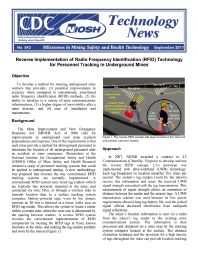Mining Publication: Technology News 543 - Reverse Implementation of Radio Frequency Identification (RFID) Technology for Personnel Tracking in Underground Mines
Original creation date: September 2011
To develop a method for tracking underground mine workers that provides: (1) potential improvements in accuracy when compared to conventional, zone-based radio frequency identification (RFID) methods, (2) the ability to interface to a variety of mine communications infrastructures, (3) a higher degree of survivability after a mine disaster, and (4) ease of installation and maintenance. Summary: Possible benefits of the reverse RFID approach include: (1) higher tracking accuracies that can average under 50 ft with tags at every other crosscut, (2) the flexibility to use a mine's existing communications infrastructure, (3) potentially higher system survivability because the tracking tags mounted in the mine are self-contained and wireless, there are no interconnecting wires to be damaged and, if some tags are lost in a fall of ground or explosion, tracking will resume when other intact tags are encountered, and (4) low-cost tags that can be quickly and easily mounted and recorded at fixed, known locations in the mine, which allows for easy expansion as mining progresses. However, as with many other tracking systems, a disadvantage is that tracking information will not be updated after a mine incident or emergency if the communications infrastructure is not operational.
Authors: TM Ruff
Technology News - September 2011
NIOSHTIC2 Number: 20039807
Pittsburgh, PA: U.S. Department of Health and Human Services, Public Health Service, Centers for Disease Control and Prevention, National Institute for Occupational Safety and Health, DHHS (NIOSH) Publication No. 2011-209, TN 543, 2011 Sep; :1-2
See Also
- Demonstration of Inertial Sensor Tracking and Communication System
- Design and Demonstration of a Location Tracking System for Underground Coal Mines (Award 1)
- Emergency Communications and Tracking
- Exploration of Two Position Adjustment Methods for Underground Mine Tracking Systems
- Passive Fiber Optic System for Locating, Tracking, and Communicating with Personnel in Coal Mines
- Performance and Safety Investigation of Emergency Backup Batteries and Battery Charging Systems for Underground Mining Applications
- Survey of Electromagnetic and Seismic Noise Related to Mine Rescue Communications: Volume I - Emergency and Operational Mine Communications
- System Reliability and Environmental Survivability
- Technology News 546 - Medium Frequency Mine Emergency Communications—An Emerging Technology
- Wireless Mesh Mine Communication System
- Content source: National Institute for Occupational Safety and Health, Mining Program


 ShareCompartir
ShareCompartir
